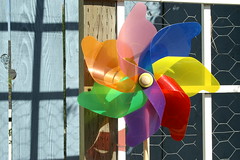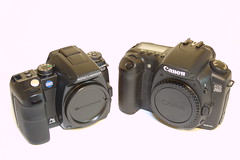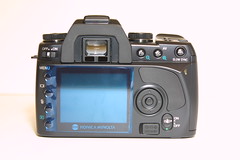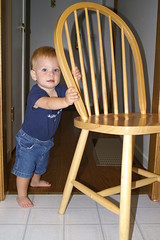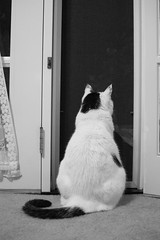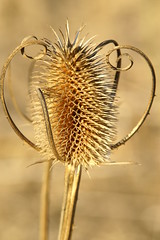Minolta Maxxum 5D GuideThis Minolta digital SLR guide is going to dig into all of the details of the Minolta Maxxum 5D. I had the opportunity to use the camera extensively over a two-week period and this guide is the result. Overall my experience was positive. Even though this is only the second digital SLR camera offered by Minolta (the first was the Maxxum 7D), they got a lot of things right. The best part is the built-in anti-shake system, which is an incredibly useful feature for people with unsteady hands like me. The built-in flash on this camera is also one of the best that I have seen. |
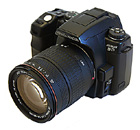 |
Who This SLR is For
The Minolta 5D is a great camera for you if you enjoy taking portraits, or if you usually take photos in low-light conditions.
This is also a good camera for the technology-phobic. It is one of the most user-friendly digital SLR cameras I have tried.
It is exceptionally easy to take photos with the Konica Minolta Maxxum 5D.
Die-hard action photographers may be disappointed with the speed of the 5D.
There is a slight delay between pressing the shutter button and taking the photo, which can lead to some missed photo opportunities.
Key Features
You can't have a Minolta digital SLR guide without a feature list:
- 9-area autofocus system
- 3 photos per second
- Maximum shutter speed of 1/4000 of a second
- Compatible with all Maxxum AF lenses
- Color and black and white mode
- 6.1 megapixel CCD sensor
- 1.5 times crop factor
- ISO settings from 100 to 3200
- 2.5" LCD
- Stores photos on Compact Flash type I and II cards
Oddities
There are only three that I could find, and two are mostly a matter of preference.
You might not find anything at all wrong with the camera if you did your used it yourself.
Overexposed Photos
First, I noticed that the camera's light meter wants to expose for shadows when no adjustments are made.
Since the camera tries to make all shady areas bright, bright sections of the photo wind up overexposed, causing bright white spots on an otherwise fine photograph.
I admit that this happened in high-contrast situations where most digital SLR sensors would have trouble.
Muted Colors
Default color capture also wasn't quite as vibrant as I like. Take a look for yourself at the photo samples at the bottom of this page.
I took several shots of really bright primary color objects, and the color did not "pop" quite as much as I expected it to.
While this sort of thing can be adjusted with an image-editing program, you would not want to have to do this with every single photo you take.
LCD and Battery Life
Finally, the large LCD (which many would consider a benefit) also has its minor drawback.
As you are using the camera, all of the camera settings are displayed on the LCD, as well as an image of the last photo you took.
Using the 2.5 inch LCD to display all of this information eats away at the battery faster than other cameras that use smaller, more power-friendly displays.
If you purchase a second battery when you get the camera, this won't ever be an issue.
How This SLR is Different
If you read other Minolta digital SLR reviews, you'll quickly find out why this camera stands apart from the competition: anti-shake.
Camera shake is the bane of photographers. Professionals find every way that they can to brace the camera against a wall, a door frame or anything else that will keep it stable.
Camera shake is magnified when you are using lenses with long focal lengths (anywhere from 200mm to 600mm).
When you have your zoom set to 200mm and you look through the viewfinder, the image is jiggling all over the place.
It can't be helped - your hands just aren't that steady.
Anti-shake compensates for this and keeps the camera's sensor stable, even when your hands are shaking.
While most anti-shake systems are built into lenses, the Minolta's is built into the camera itself.
The sensor sits in a holder that keeps it steady even when the camera body is being moved around. See a video of this
The anti-shake system will work with any of the compatible Minolta lenses.
As part of my Minolta digital SLR guide, I took a lot of photos testing the stability of the anti-shake system. You can see some of those image sequences in the photo samples below.
Look and Feel
In this section of this Minolta digital SLR guide, I'll focus on the camera's size, weight and controls.
While it is neither the lightest nor the smallest (see the article on small-sized digital SLR cameras) it is also not the largest digital SLR you can buy.
This image shows the size of the Minolta compared to the Canon EOS 20D, which is a large heavy digital SLR. There is not a huge difference, but you should be able to see the Minolta is smaller.
Easy To Use
All the camera's controls are right where you want them.
You can change ISO, Shooting Mode (One-shot, Continuous, Timer), Autofocus/Manual focus toggle, and white balance setting without using a single menu.
The dial to set the white balance is unique to the Minolta 5D - on most other digital SLRs you have to push a button then turn a selection wheel to set it.
Camera Information Display
The camera doesn't have a display on the top of it, which is also a big difference from other digital SLRs.
Most cameras have a small display panel for camera settings on the top, and then the large LCD on the back.
The Minolta displays all of the camera settings on the back LCD panel, which makes it really easy to change settings while you're taking photos.
Think about it. You're holding the camera up to your eye to take a photo.
You want to change the ISO. With a top panel, you have to drop the camera or flip it up to see what the ISO is set to.
With the Konica Minolta 5D, you just check the LCD on the back, change the setting, and go right back to taking photos. The whole process is pretty smooth.
Changing Camera Settings
The Minolta features two controllers, a rotating dial right in front of the shutter button and directional buttons on the back of the camera where under your thumb.
The camera is easy to operate in manual mode, and changing shutter speed and aperture can be done without taking your eye away from the viewfinder.
How It Works
The Minolta Maxxum 5D has some features that really surprised me. I'll try to get to them all in this Minolta Maxxum 5D guide.
Impressive LCD
Here's the first one: the information display on the camera's LCD rotates depending on how you hold the camera.
It switches back and forth from portrait to landscape. While this may not seem like much, it makes it very easy to tell what you camera settings are no matter how you are holding the camera. You don't have to crane you neck to see the camera settings.
It's a small thing, but it really improves the camera's ease of use.
Here's something else that I haven't read in other Minolta digital SLR reviews: the LCD automatically shuts off when you put your eye up to the viewfinder.
Again, this is a small thing, but it helps when you are taking photos at night.
The LCD is a very bright display (at 2.5 inches it puts out a lot of light). It is really nice not to have that light shining in your eyes when you're looking through the viewfinder and trying to compose a photo.
Fantastic Flash
The flash on the Minolta Maxxum 5D is exceptional.
I am usually not impressed with the built-in flash units on digital cameras and choose instead to use an external flash.
I took several photos with flash and without. I was completely surprised when some of my flash photos turned out better than the ones without (this is a rare occurrence).
Colors were bright and vibrant (they are usually washed out with flash) and there was not an abundance of harsh shadows, a common element of all flash photography.
Again, take a look at some of the photos that I took for this Minolta Maxxum 5D guide, and be the judge yourself.
A Wide Range of ISO
The Minolta 5D lets you set the cameras ISO from 100 to 3200.
The biggest problem with high ISO settings is that the image gets very noisy. You can see lots of points in what should be a smooth continuous photo.
The 5D performed quite well when I was performing tests for this guide.
I took the shot on the left indoors at night holding the camera in my hands. These conditions should have created a blurry photo.
With the ISO set to 3200 though, I didn't have to get out my tripod just for this simple shot.
Can you see any grain or noise?
I admit that it's hard to see noise at this image size. Click the photo for a larger version.
Slower Response
The consecutive photo speed on the Minolta 5D is not quite fast enough for the dedicated action photographer.
I spent a lot of time with the camera photographing my son, and there were times where I was ready but the camera wasn't.
I am biased: I am used to the fast response of the Canon 20D, so my opinion is overly critical.
If you've been using a compact digital camera, the Minolta 5D will seem plenty fast to you.
The good news is that the autofocus response on the Minolta is equivalent to the Canon 20D. I sat in a fairly dark room with just one overhead light, with both cameras in my lap.
I then would use each camera to focus close, far away and back to close again. This is a pretty good test of the responsiveness of the autofocus system.
While I expected the Canon to do a good job, the Minolta Maxxum 5D stood up to the test.
The Pros and Cons
| Pros | Cons |
|
|
Price Analysis
The Maxxum 5D is one of the cheapest digital SLRs you can buy.
Here's the price comparison:
| MAKER | CAMERA | PRICE |
| Minolta | Konica Minolta Maxxum 5D 6.1MP Digital SLR Camera with Anti Shake (Body Only) |
$ 600.00 |
| Nikon | Nikon D50 6.1MP Digital SLR Camera (Body Only) |
$ 600.00 |
| Olympus | Olympus EVOLT E500 8MP Digital SLR (Body Only) |
$ 700.00 |
| Pentax | Pentax *istDS2 6.1MP Digital SLR Camera (Body Only) |
$ 750.00 |
| Canon | Canon Digital Rebel XT 8MP Digital SLR Camera (Body Only - Black) |
$ 800.00 |
Minolta Maxxum 5D Kit
The most common Minolta Maxxum 5D Kit comes with an 18-70mm f/3.5-5.6 lens, which runs about $700.00.
Konica Minolta is currently offering a $50 mail-in rebate for this kit until February 28, 2006.
Camera Body
If you just want the camera body without a lens, it will cost about $600.00 (Check latest price)
Lenses for the Maxxum 5D
Not sure what kind of a lens you need? Read our guide to digital SLR lenses.
If you'd like a lens that's a better match for your photography style than the one that comes with the kit, here are some alternatives for you to consider.
| PHOTO STYLE | LENS | PRICE |
| Landscape, indoor, low-light | Sigma 24-70mm F2.8 AutoFocus Zoom Lens with Hood | $ 400.00 |
| Wildlife, birds | Sigma 50-500mm f4-6.3 Telephoto Zoom Lens with Hood | $ 970.00 |
Deals on the Minolta Maxxum 5D
Minolta 5D Photo Samples
Click on any one of the sample photos below to view a larger version.
 |
 |
 |
 |
 |
 |
 |
| Digital SLR Home | Other Camera Guides |



